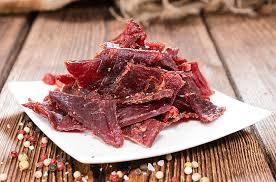Meat Snacks Market Growth Challenges Hindering Global Industry Expansion
The meat snacks market, which includes products such as jerky, sticks, bars, and dried meat bites, has enjoyed significant growth over the past decade. Driven by rising consumer demand for high-protein, low-carb, and on-the-go snack options, this market has expanded across regions and demographics. However, despite a promising outlook, several growth challenges continue to impede its full potential. These include high production costs, raw material volatility, regulatory barriers, environmental scrutiny, shifting consumer trends, and fierce competition—all of which must be addressed to ensure long-term sustainability and profitability.

Raw Material Volatility and Rising Input Costs
One of the most pressing challenges for the meat snacks market is the volatility of meat prices. Beef, pork, turkey, and chicken—common ingredients in meat snacks—are subject to fluctuating market prices driven by feed costs, disease outbreaks, weather conditions, and supply chain disruptions. These fluctuations make it difficult for manufacturers to maintain stable pricing and consistent margins.
Additionally, meat processing involves several steps such as marination, drying, seasoning, and packaging—all of which require specialized equipment, labor, and energy. The overall cost of production is therefore significantly higher than that of non-meat snacks, creating a financial strain especially for small to medium-sized enterprises.
Regulatory and Compliance Hurdles
The meat snacks industry is subject to stringent regulatory oversight regarding food safety, labeling, sourcing, and processing. In many countries, strict import/export regulations, shelf-life requirements, and meat traceability standards must be met, which complicates operations and increases compliance costs.
For brands looking to expand into international markets, navigating diverse regulatory frameworks can be both time-consuming and resource-intensive. Delays in product approvals, inconsistent food safety standards across regions, and frequent updates to regulations can create bottlenecks in market entry and distribution.
Environmental Concerns and Sustainability Pressures
The meat industry as a whole faces growing scrutiny due to its environmental impact, including greenhouse gas emissions, water usage, deforestation, and ethical concerns related to animal welfare. As consumer awareness of sustainability increases, brands are under pressure to demonstrate environmentally responsible practices.
Sourcing sustainable or organic meat, investing in regenerative agriculture, and shifting to eco-friendly packaging materials are all essential steps—but they come at a significant cost. For many producers, especially smaller ones, these requirements pose a considerable financial and operational burden, slowing down scalability and growth.
Changing Consumer Preferences and Dietary Shifts
While meat snacks have historically appealed to consumers seeking protein-rich, low-carb options, the rise of plant-based diets, flexitarian lifestyles, and vegan alternatives is shifting consumer behavior. A growing segment of the population is reducing or eliminating meat consumption due to health, ethical, or environmental motivations.
This shift has introduced plant-based snack competitors to the market, which appeal to health-conscious and environmentally aware consumers. Meat snack producers now face the dual challenge of retaining traditional consumers while appealing to the increasingly diverse dietary landscape. Reformulating products, developing hybrid options, or introducing plant-based lines may help—but these strategies require time, research, and investment.
Intense Market Competition and Brand Differentiation
The meat snacks category is crowded with brands, from multinational food corporations to local artisanal producers. New entrants are regularly emerging, often with niche positioning such as exotic meats, organic ingredients, or unique flavor profiles. This has led to a saturated market, where standing out requires more than just product quality.
Brand differentiation is becoming increasingly difficult. To capture consumer attention, companies must invest in compelling branding, digital marketing, and innovation—areas where established brands typically have more resources. Smaller players struggle to compete for shelf space, online visibility, and customer loyalty, limiting their growth prospects.
Distribution and Retail Limitations
Access to retail shelf space and distribution networks remains a growth barrier, especially for new or regional meat snack brands. Large retailers often prioritize well-established products, leaving little room for newer players to enter. Additionally, the perishable nature of some meat snacks and the need for temperature-controlled storage add logistical complexities.
Though e-commerce has opened new sales channels, it introduces its own challenges such as fulfillment logistics, packaging durability, and managing product shelf life during shipping. Brands must develop efficient, scalable distribution models to achieve widespread market penetration.
Innovation Constraints and R&D Costs
Innovation in meat snacks—such as introducing new flavors, formats, or functional ingredients—is crucial for market growth. However, developing new products involves significant R&D investments, especially when ensuring regulatory compliance and maintaining product quality.
Manufacturers must balance innovation with cost-effectiveness, and not all can afford the risks associated with trial-and-error development. Delays in product rollouts or failed launches can hinder a brand’s ability to grow and compete in a fast-moving market.
Conclusion
While the global meat snacks market holds immense promise, it faces several growth challenges that must be strategically addressed. From raw material volatility and regulatory complexity to evolving consumer preferences and fierce market competition, these hurdles threaten to slow industry expansion and limit new opportunities.
To overcome these obstacles, companies must embrace innovation, diversify their offerings, invest in sustainability, and build strong digital and retail partnerships. With the right strategies and adaptability, meat snack manufacturers can mitigate these growth barriers and continue to thrive in an evolving global food landscape.
- Art
- Causes
- Crafts
- Dance
- Drinks
- Film
- Fitness
- Food
- Games
- Gardening
- Health
- Home
- Literature
- Music
- Networking
- Other
- Party
- Religion
- Shopping
- Sports
- Theater
- Wellness


